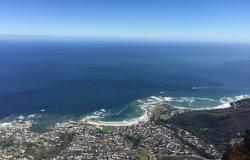Cape Town’s Crisis shows us the Real Cost of Water

Sometime this summer, residents of Cape Town, South Africa, are expecting ‘Day Zero’ – the day when almost all the taps in the city will run dry. On that day, its 4 million inhabitants will have to queue at approximately 200 designated sites when they want water.
With all the attention on how Day Zero will impact household use, we are left to wonder what city residents will have to eat and how expensive that food will be. The region’s agriculture, which has long benefitted from nearly unlimited access to the local water supply, is also experiencing a rude awakening. And that’s a big part of the problem.
This tragedy wasn’t inevitable. The city authorities have known that the city and its agriculture were drawing more water from reservoirs than is being replenished. And this has only got worse since the drought hit in 2015. But drought and bad planning are only partly to blame. There is a deeper issue at work: the cost of water is invisible. Nowhere is its cost fully accounted for, not even in agriculture.
The lack of accounting for the cost of water in agriculture is not unique to South Africa. It is a global crisis, and Cape Town is not the first red flag. California’s recent water crisis prompted mandatory water restrictions in urban areas, but not for agriculture – even though California farms use 80% of the state’s surface water. Similarly, when São Paulo, Brazil, recently tapped out the water supply for its 20 million residents, 59% of the state’s water continued to flow to agriculture and industry.
The world faces a looming water disaster, one that could dry out our food systems. Even as climate change disrupts rainfall patterns, global water demand is projected to increase by 55% by 2050. While agriculture is not the only driver of increased water demand, the world’s growing population will need more food, putting further strain on already limited water resources – resources that do not enter into the market value of the food on our plates.

More than any other economic sector, agriculture depends on the natural services provided by healthy ecosystems, of which free water is just one. Those services also include the provision of fertile soil, pollination, and the biological diversity of plants, including the wild relatives of our current food crops. But none of these services are endless. And unless we pay for them, they will not last.
Around 60% of ecosystem services have been degraded already. With extreme weather events on the rise, threats to global food production and the potential of food-price crises are increasing.
Valuing ecosystem services and formally accounting for their use, in the same way that we account for flows of financial resources through businesses, would be a game changer, enabling society to measure and manage what agriculture draws from nature, starting with water.
Of all the water on Earth, only 3% is freshwater, supplying our drinking needs, food production, sanitation, and power generation, and hosting a range of vital biodiversity. Irrigated agriculture currently draws 70% of this water. And of this, a huge amount of it is wasted. In South Africa, where over half of water use is for irrigation, less than 60% of it is correctly placed in the root systems of plants.
Only an honest accounting of the value of water can ensure its wiser use. The ‘true cost’ of a not-so-humble hamburger, for instance, includes many impacts beyond its market price: from the carbon dioxide emitted by its transportation; to deforestation for growing livestock feed; the water used for livestock grains; as well as the health costs associated with eating too much beef. Thus, even this seemingly inexpensive food is, in fact, expensive.
Understanding these costs, and allocating them appropriately, should prompt a rethinking of what foods we produce and how we do so. For example, people can choose to eat, and farmers can choose to grow crops that require less water.
Meat production requires much more water than vegetables – anywhere between 5,000 litres of water for 1kg of chicken, and 20,000 litres for 1kg of beef. By comparison, producing 1kg of wheat requires between 500 and 4,000 litres of water. And it takes 17,000 litres to produce a kilo of chocolate.
As such, accounting for the cost of water in the price of food and switching to food crops that use less of nature’s services is not just good environmental sense, it is essential to sustaining a global food supply that is expected to feed 8.5 billion people by 2030.
Cape Town will no doubt find a solution to its water crisis. Ongoing attempts at drilling boreholes and desalination are expensive, but promising. Nonetheless, the experience will leave scars in an already troubled society – and ones that will take a long time to heal.
Meanwhile, on the global front, a failure to recognise the value of ecosystem services in agriculture poses a major threat to food security. Better accounting now of the cost of water, particularly for the foods we grow and consume, just might prevent a global Day Zero and keep alive our aspirations for a food secure and bountiful world.
Maxwell Gomera, Director, Biodiversity and Ecosystem Services Branch, UN Environment.
This post first appeared on the Agenda blog.
Image credit: catherinecronin via Flickr (CC BY-SA 2.0)

